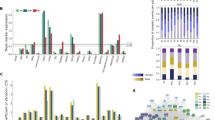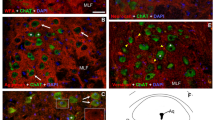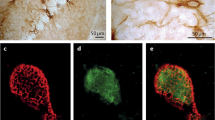Abstract
The difficulty of working with the intact brain in vivo has led to the increasing use of nerve cell cultures in neurobioiogy. However, dissociated cells cannot be unambiguously identified by morphological criteria before the third week in culture, for it is not until then that the basic morphology and size of neurones become stable so that these and other cell types can be easily distinguished1. However, cultured neurones can be identified by various cytochemical techniques based on (1) the detection of neurotransmitters or receptors for transmitters2–4, (2) the presence of the Thy 1 antigen and the receptor for tetanus toxin, which are present on the membrane of most neurones5, and (3) the presence in neurones of neurone-specific enolase (NSE), a cytoplasmic enzyme, which can only be identified on fixed specimens6,7. Furthermore, other cell types in culture can also be specifically labelled. For instance, antisera to galactocerebroside bind selectively to oligodendrocytes8, and antibodies to a neural tumour bind selectively to Schwann cells5,8,9. We report here the selective interaction of phosphorylcholine-binding myeloma proteins (PC-BMP)10 with mouse neurones hi culture and in suspension. Phosphorylcholine (PC) is found as part of lecithin and sphingomyelin molecules in variable amounts in eukaryotic and prokaryotic membranes, including plasma membranes11–13.
This is a preview of subscription content, access via your institution
Access options
Subscribe to this journal
Receive 51 print issues and online access
$199.00 per year
only $3.90 per issue
Buy this article
- Purchase on Springer Link
- Instant access to full article PDF
Prices may be subject to local taxes which are calculated during checkout
Similar content being viewed by others
References
Ransom, B. R. et al. J. Neurophysiol. 40, 1132–1150 (1977).
Dvorak, D. J., Gipps, E. & Kidson, C. Nature 271, 564–566 (1978).
Woodward, W. R. & Lindström, S. H. Brain Res. 137, 37–52 (1977).
Lasher, R. S. Brain Res. 69, 235–254 (1974).
Fields, K. L., Brockes, J. P., Mirsky, R. & Wenden, L. M. B. Cell 14, 43–51 (1978).
Schmechel, D. et al. Science 199, 313–315 (1978).
Hooghe, E. L., Dubois-Dalcq, M. & Schmechel, D. Lab. Invest. (in the press).
Raff, M. C. et al. Nature 274, 813–816 (1978).
Brockes, J. P., Fields, K. L. & Raff, M. C. Brain Res. 165, 105–118 (1979).
Potter, M. Adv. Immun. 25, 141–210 (1978).
Nilsson, O. S. & Dallner, G. Biochim. biophys. Acta 464, 453–458 (1977).
Trams, E. in Function and Biosynthesis of Lipids (eds Bazan, N. G., Brenner, R. R. & Giusto, N. M.) 153–173 (Plenum, New York, 1977).
Ansell, G. B., Hawthorne, J. N. & Dawson, R. M. C. (eds) Form and Function of Phospholipids, 464 (Elsevier, Amsterdam, 1973).
Morse, H. C. et al. J. Immun. 118, 1682–1689 (1977).
Morse, H. C., Pumphrey, J. G., Potter, M. & Asofsky, R. J. Immun. 117, 541–547 (1976).
Cebra, J. J. & Goldstein, G. J. Immun. 95, 230–245 (1965).
Matsuya, Y. & Green, H. Science 163, 697–698 (1969).
Dubbs, D. R. & Kit, S. Expl Cell Res. 33, 19–28 (1964).
Littlefield, J. Science 145, 709–710 (1964).
Minna, J. et al. Proc. natn. Acad. Sci. U.S.A. 68, 234–239 (1971).
Campbell, G. L. M., Schachner, M. & Sharrow, S. O. Brain Res. 127, 69–86 (1977).
Author information
Authors and Affiliations
Rights and permissions
About this article
Cite this article
Hooghe-Peters, E., Fowlkes, B. & Hooghe, R. A new neuronal marker identified by phosphorylcholine-binding myeloma proteins. Nature 281, 376–378 (1979). https://doi.org/10.1038/281376a0
Received:
Accepted:
Published:
Issue Date:
DOI: https://doi.org/10.1038/281376a0
This article is cited by
-
Higher levels of myelin phospholipids in brains of neuronal α-Synuclein transgenic mice precede myelin loss
Acta Neuropathologica Communications (2017)
-
Ontogeny of hormone-secreting cells of the rat pituitary gland: An immunocytochemical study on dissociated cells
The Histochemical Journal (1989)
Comments
By submitting a comment you agree to abide by our Terms and Community Guidelines. If you find something abusive or that does not comply with our terms or guidelines please flag it as inappropriate.



